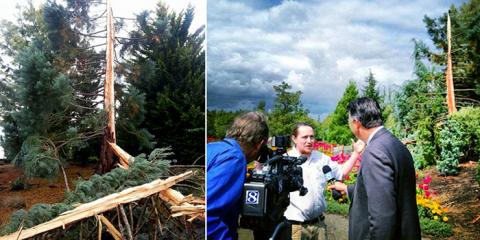Lightning strikes close to home
September 24, 2013
Those visiting The Oregon Garden usually stroll and meander among the trees and plants. Life seems to move at a slower pace there, as visitors often take the time to watch the plants grow and the birds fly by. But on a Thursday afternoon two weeks ago, the Mother Nature Show suddenly changed channels – to watching black clouds unleash a powerful thunderstorm. Visitors and staff retreated to The Oregon Garden Resort’s Garden View Restaurant to watch as more than two inches of rain fell amid lightning flashes. Soon everyone began to note that there was no “counting” time between the thunder boom and the flash of lightning. Then the powerful show suddenly lit up the sky as an “explosion” occurred.
A 30-foot giant sequoia located in the conifer garden was struck by a lightning bolt. It split exactly down the middle; the top and branches lay conveniently in a pile at the base of the tree. Nearby, flower displays and pathways were barely touched or disturbed.
The storm caused local street flooding and widespread power outages. It also brought 15 minutes of fame to The Oregon Garden and employee Matt Stageman. Matt was on hand to witness the lightning strike, and took action to make sure the area was safe for returning visitors. The arriving media also interviewed him the next day. Temporary signage and a viewing area were erected the next day, with the damaged sequoia becoming the hottest stop on the garden tour. The Oregon Garden intends to leave the giant sequoia snag, as long as safety allows.
According to the National Weather Service, an average of 25 million lightning strikes are detected each year in the United States. This strike happened to be close to home. No one knows why lightning chose this tree; it was not the tallest or the biggest tree in the area. The Douglas-firs of the Rediscovery Forest sit taller, and on top of the hill – and they were left untouched. The heritage Oregon white oak sat undisturbed, as it has for over 400 years. The conifer garden has 531 unique conifer trees, but this was the chosen one.
Giant sequoias occur naturally only in groves on the western slopes of the Sierra Nevada Mountains of California. The species is named after Sequoyah (1767–1843), the inventor of the Cherokee syllabary. This chosen giant sequoia was already a special tree to one family, which years ago dedicated it as a memorial tree for their father. The family was notified the next day, and they support leaving the tree as is – to see what comes next in this tree’s story.
From the woods,
Julie Woodward
